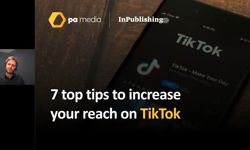Ensuring a magazine has an in-depth editorial and a healthy circulation used to be an editor’s priority. Today, in this digital age, there is so much more to think about – online content, social media and, of course, the app edition. Readers now want a great experience across platform and that means 24/7 coverage, interactive digital, great video content and engaging social media to accompany their print issue.
Step forward Simon Collis, editor of Cycling Weekly and winner of the 2015 BSME Digital Editor (Consumer) award. Judges cited the magazine’s website as one that oozes authority; you feel the team lives and breathes the title – and you’d never know the brand was 124 years old.
Five outstanding editors were shortlisted, but what was it that made Simon Collis stand out from iconic brands such as Radio Times or National Geographic? When asked why the judges chose Simon, Dickon Ross, chair of the BSME, explained that it was the content and repositioning of a brand that marks its 125th birthday this year that made his entry standout. “He repositioned the brand with exclusives and clever videos optimised for social media, leading to phenomenal growth in market share.”
For Simon, winning the award was a great end to a year that both he and his team are incredibly proud of and a good start to 2016. “In the space of a year, we went from fourth in the UK market to first, and we beat all the targets we'd set for ourselves.
“We don't jump out of bed in the morning because we want to win awards – we do it because we love cycling, we love the passion of our audience and we love creating content that inspires our readers – but it's still a nice bonus when your peers recognise that you've done a good job.”
Know your audience
It is this passion that perhaps has made the magazine published by Time Inc UK such a success. Simon recognises winning the award was a result of the magazine’s online growth. “Our figures were really strong and spoke for themselves – we're about three times bigger than we were a year ago, peaking at 2.5m unique users during July.”
Those figures have shown a fantastic growth rate with a monthly average of unique users at 1,552,437 (Jan–Nov 2015) – an increase of 141% year-on-year. Average page views have also shot up with Cycling Weekly achieving 5,897,882 denoting an increase of 149% year-on-year (Jan-Nov 2015). While print figures were not available for the current year, last year’s ABC was 26,273. Not bad for a weekly title on a sport that has only recently become mainstream.
He also attributes winning to the sustainability of the brand. “I also think that the judges liked the overall narrative of a 125-year-old brand proving its relevance and adaptability in an environment that couldn't have been dreamt of in 1891.”
Avoid lazy journalism
There isn’t one digital strategy that Simon endorses as being the most successful, but cites social media as being high on the agenda stating that the team designs all of their content including headlines and angles, to invite clicks and shares.
“We try to maintain high quality in everything we do – digital media shouldn't mean lazy journalism. Even though we're a small team, we commit to publishing content whenever it happens – whether that's the day, night, weekend, whatever,” he says.
There have been significant changes in digital content, admits Simon, since he launched a magazine website in 2001. “It was one page, listing what was in the current issue and another with a contacts list. The millions of page impressions we do now is from another planet.”
But what makes a successful digital brand extension very much depends on that brand.
“Cycling has broken out of a niche and is now part of the mainstream, so our aim was to grow as much scale as possible. For that reason, the key principle for us is never to be restricted by our heritage, or by how we would approach things from a print perspective.
“We go where our audience wants to go. It can be exhaustive technical info combining pictures, video and more words than we'd ever fit in a magazine article, or quick-fire lists and picture galleries. Many people want to grow their digital reach without changing the content they already produce, and in most cases, I don't think that will work.”
The secret to a successful digital provision revolves around that old adage of giving an audience what they want, and using developments in technology to maximum advantage.
“A headline format can seem innovative and engaging. But six months later, it feels clichéd and cynical. Our biggest challenge will be to continually rip up the rulebook we've written and to keep trying new things.”
Be innovative
It is this attitude along with an acute attention to detail that perhaps captured the judges’ attention. Innovation is constant with the Cycling Weekly team – and they put their readers at the heart of everything they do. One such example is their cycling video project launched in May 2015, which has three videographers working full-time producing twelve videos a week.
“From a standing start, we have delivered two million views on site in 2015 through our own player with our own advertising model. The video solutions we can now offer are helping to cement our position as the organisation best-placed to reach a powerful, high-spending demographic with authentic, passion-fuelled content.”
So what can other publishers learn from this brand?
For Simon, it’s about investment. “The biggest lesson has been that investment in digital not only works – but that it can work really, really fast.”
By contrast, a constant challenge he says is being able to accept what the data tells you. “You can follow your gut from time to time, but your audience is telling you what it wants every second of the day.”
For now, he’s applying lessons learned to sister publication Mountain Bike Rider’s off-road cycling website. “That's now one of the fastest growing sites at Time Inc UK, and is another key route to our strong demographic.”
His advice to up and coming digital editors?
“Be strong – the days when digital was subordinate to print are over. If you're not confident with numbers and data, sort it out. And remember that your audience should always feel pleasantly surprised when they click on your story – rampant clickbait will come back to bite you.”
The shortlist
Others shortlisted for the award included Pat Riddell, editor of National Geographic Traveller (UK) published by APL Media, Tim Glanfield, editor of Immediate Media’s RadioTimes.com plus Haymarket’s Marc McLaren editor of Stuff.tv and Michelle Sammet, editor of Spikes.
For Pat Riddell, being shortlisted was proof that the team’s hard work had paid off. He was delighted that his entry made it to the shortlist.
“We’ve worked exceptionally hard over the past few years to take the UK edition of National Geographic Traveller beyond a print publication into a multi-platform brand. The launch of our new website and interactive app in 2014 helped us to achieve that.”
“The ongoing focus on growing traffic and social media channels has resulted in an engaged online audience that identifies with and trusts our content,” revealed Pat, adding that it was a huge accolade to be acknowledged by the BSME judges. “We hope to capitalise on our progress next year with further developments, both online and in print.”
Marc McLaren was equally delighted to make the shortlist, which he attributes to “evidence of a clear strategy and the results to back it up”.
While citing his biggest achievement as growing traffic on Stuff by more than 150% year-on-year, Marc feels the design element has also played a crucial role in the site’s success. “I'm probably more proud of bringing some of the print edition's design flair to the website. I think it's important for a website to take design every bit as seriously as any print magazine does.”
Stuff’s biggest challenge, explains Marc, has been SEO problems. “As a primarily reviews-focused site, our Google ranking is very important to us, but as a smaller site than many of our competitors, we struggle to get in the first couple of results for most products. We overcame this via a strategy specifically designed to get our reviews ranking well. It required lots of hard work but ultimately paid off.”
Although he refused to divulge Stuff’s future editorial strategy, Marc did say that his main priority is “to keep publishing great content every day”.
Editor of spikes.iaaf.org, Michelle Sammet admits she didn’t expect to make the shortlist. “I was actually pretty intimidated by the other titles. What I think made the entry stand out, however, was that despite Spikes not being a huge brand, we have a rather disproportionate influence in the industry.
“For us, it is all about bringing athletics to a wider audience in a way that is fun and engaging and I think various campaigns have done exactly that – get people to talk about the characters in the sport rather than just the times and distances.”
Michelle feels her team’s biggest achievement was “getting tens of thousands of people to follow a sport that is currently going through an existential crisis”.
“While nearly every athletics-related story in the mainstream media is focusing on the negatives, we have made it our mission to celebrate the great personalities, of which there are plenty in our sport, and our readers seem to be grateful for the positivity we bring.”
Editor of RadioTimes.com Tim Glanfield was delighted to be among the top five. “I hope the entry stood out because it was about good journalists and fantastic ideas making a real difference at a time when churnalism and sensationalism are often the fallback position of online publications.”
He said he is “incredibly proud to have led such an historic and well-loved brand into an exciting and challenging digital landscape”.
Tim says his proudest achievement has been assembling such a passionate and creative editorial team. “The success and rapid growth from a million to nine million monthly users is extremely gratifying, but the thing that has pleased me most is seeing journalistic flair and quality content continue to prosper at a time when doom and gloom so often surrounds the future of our profession.”
There is no doubt that industry awards like the BSME’s Digital Editor of the Year play an important role in achieving recognition for those talented editors who are meeting the challenges of our digital age head on. Awards spur on those who are doing a fantastic job, while encouraging the industry’s newest talent who are just starting out and have yet to fulfil their potential.
Here’s to innovation, passion and a steadfast dedication to magazines.












